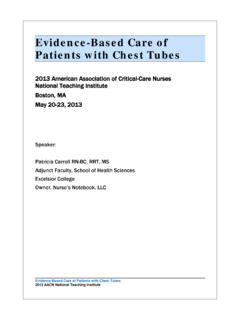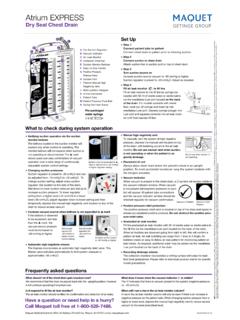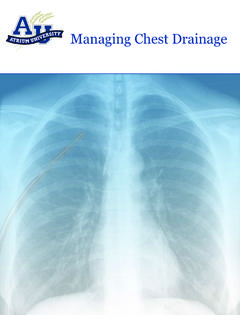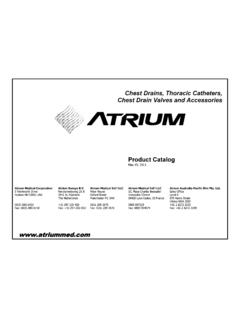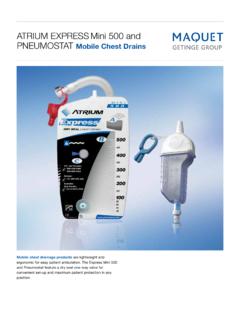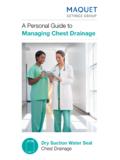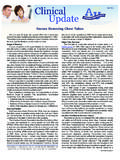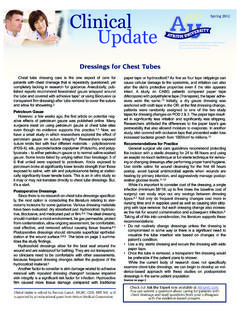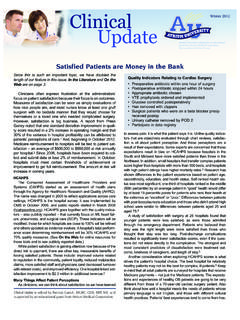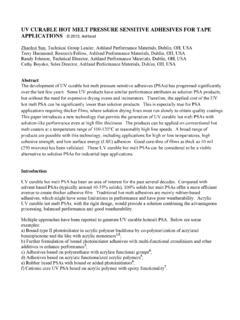Transcription of Medical Adhesive Safety - Atrium Med
1 Last fall, an expert panel published recommendations forreducing the risk of Adhesive -related skin the injuries related to Adhesive removal annually,2it s remark-able that the only English-language guidance published beforethis was limited to neonates. We ll cover tape information here,and urge you to read the full guidelinesfor more about skin careand types of damage related to tape 101 While we use Medical tape every day, most of us have had verylittle education about the components that make up a roll of tape,the different types of tape and indications for each. The FDAdefinesa Medical Adhesive as a strip of fabric material or plastic,coated on one side with an Adhesive , and may include a pad ofsurgical device is used to cover and protectwounds, to hold together the skin edges of a wound, to support aninjured part of the body, or to secure objects to the skin.
2 Whilemedical adhesives can be tapes, dressings or devices, we ll usethe term tape are four layers in a traditional Medical Adhesive :The release coating prevents the Adhesive from sticking to itself sothat it s easy to remove the tape from the roll. Generally speaking,the backing can be paper, plastic, cloth, foam and/or elastic;1adhesives can be natural (latex) or synthetic (non-latex) rubber,acrylic, or silicone. The combination of the layers determines theproperties and clinical performance of the product, and you mustevaluate them backing layer provides tapes withmost of their cohesive mechanical strength and determineswhether the tape is stiff or conforming, whether skin under the tapeis visible, and the degree of permeability to gases and ,2 Since Medical tapes need to adhere to skin, their properties arevery different from tapes designed for other purposes. The skinsurface is continually sloughing, so the tape needs to adhere to asurface being shed; the surface has water, oil, salt, loose debrisand often lotion or cream; the skin is highly lipid, making ithydrophobic; and it has elastic addition, the skinsurface is very irregular with ridges and that s not enough, tapes need to be able to handle moisturevapor that normally leaves the skin.
3 This is called the moisturevapor transmission rate (MVTR), and it depends on the chemicalcomposition of the Adhesive , the tape thickness and the perme-ability of the ,5 Finally is biocompatibility the tape must be nontoxic, hypoal-lergenic, and compatible with skin cells. When you consider thatmost standards for routine Adhesive testing call for tape to stick tostainless steel, you can see how complicated skin adherence ideal tape must be compatible with skin, adhere strongly, bepermeable to air and moisture, and remove gently without , those that have the strongest securingproperties are usually very difficult to TechnicalTapes are called pressure sensitive adhesives (PSA), meaningthey adhere to the surface best with application of light pressureon the you always apply pressure when you put tapeon the skin? Over time, Adhesive will warm and flow to fill gaps inthe skin surface, strengthening the are three measures of Adhesive strength tack is thequick initial adhesion before pressure is applied; peel adhesion isthe ability to resist removal by peeling, peel force is the forcerequired to remove the Adhesive from the surface.
4 And shear isthe ability to maintain a bond when loaded the load can be secur-ing a weighty device to the skin or trying to conform a stiff tape toa curved ,5 Clinicians typically assess tape by how stickyit feels the tack but that has little to do with adhesion to the seems like the greater the peel force, the greater the potentialskin damage, but silicone Adhesive on a foam backing had lessdamage with a moderate pull force while hydrocolloid Adhesive ona foam backing had more damage with a lower pull expert panel standardizes the name of skin damage relat-ing to tape as Medical Adhesive -related skin injury (MARSI) anddefines it as ..erythema and/or other manifestation of cutaneousabnormality (including, but not limited to vesicle, bulla, erosion, ortear)[that] persists 30 minutes or more after removal of the adhe-sive. 1 Injury occurs when the Adhesive bond between the tapeand the skin s surface is stronger than the bond between skin lay-ers, leaving skin attached to the tape as it is removed.
5 Whilemultiple factors contribute to injury, including peel force, adhesivecharacteristics, occlusiveness, and rigidity of the backing, patientsat both ends of the age spectrum are at greatest risk, along withthose who are malnourished or ,2,6A study of personsage 65 and older found 71% of MARSI were contact dermatitis,21% trauma, and 9% allergies to Adhesive arerare; contact dermatitis is much more ,6 Adhesive SelectionWhen selecting the tape product, consider both patient andproduct characteristics:1 Medical Adhesive SafetyClinical Update is edited by Patricia Carroll, MS, RN-BC, CEN, RRT, andsupported by an educational grant from Atrium Medical 2014 Continued on page 2 Summer 2014In the LiteratureEnhancing ICU RoundsAn article in the current issue of Critical Care Medicinereports on astudy describing implementation of a daily goal checklist to facilitatemorning ICU rounds. The checklist is broken down by comfort, seda-tion, Safety , and prophylaxis; lines, tubes and drains; fluid status;infection prevention; ventilation; nutrition; diagnostics; meds; psy-chosocial; research; and consultations.
6 A pre-rounds section iscompleted by the overnight nurse, and the rounds section isaddressed by the whole team. Key benefits of the process were:rounds more systematic and organized, multidisciplinary input wasfacilitated, checklist is a centralized concise summary of the plan,ensures comprehensive approach to care, emphasizes patient-spe-cific goals, and enhances teaching on rounds by prompting teachingtopics. If you re looking for ideas to improve your rounds checklist,this is a great : Centofani, et al: Use of a daily goals checklist for morning ICUrounds: a mixed-methods study. Critical Care Medicine2014;42(8) CitationA New Alcohol Intoxication ScaleThe current issue of the Journal of Emergency Nursing includes astudy describing development of a behavior-based tool for assessinglevel of intoxication created in response to logistical challenges hold-ing up transfers that were based on blood alcohol (BAC) levels.
7 Sincethere is not a great correlation between BAC and behavior, this newtool facilitates decision-making for intoxicated patients : Volz, TM: The development of a behaviorally-based alcohol intoxicationscale. Journal of Emergency Nursing2014;40(4):330-335. PubMed CitationA New Angle on Nurse BullyingResearchers writing in the latest issue of the Journal of NursingScholarshipnote that bullies who shout and scream are easy to iden-tify, but most bullying in nursing is far more subtle. The researchersexamined the manner of speaking rhythm, stress, intonation, wordchoice and physical presence that they call were a culture in which this behavior was expected byvictims and tolerated by others, bullies use lies and choose andshape facts selectively, and victims were overwhelmed by their pub-lic shaming. While this article is not an easy read, it s an importantcontribution on a vital : Dzurec, LC, et al: Unacknowledged threats proffered in a manner ofspeaking: recognizing workplace bullying as shaming.
8 Journal of NursingScholarship2014;46(4):271-280. PubMed CitationCritical care training programs are putting more of theireducational content online and sharing their curriculaand research with all who are interested. The MarylandCCProject is an open-source project cre-ated and maintained by the University of Maryland Critical Care fellows. Critical Care / Acute Care Surgery is the site from the Orlando Regional Medical Center s fellowship program in Florida. SOON! We're proud to announce that you will be able to earn one contact hour for reading Clinical Update. We'll let you know as soon as it's available through our education partner, Nurse's Notebook. Is the tape needed to secure a critical (essential to patient Safety )or noncritical device or dressing? How long will the tape be in place? Is the skin area smooth or contoured; likely to move or comeunder friction; dry or exposed to moisture, perspiration, humidity,exudate or body fluids?
9 What is the strength of the tape over time? Does the tape stretch, breathe, conform to the area; is it flexibleand strong?Remember that developing or resolving edema causes significantskin movement. Do and Don tThe panel s recommendations include practices to follow andthose to avoid:1 Consider using a barrier film to protect skin, but avoid alcohol orsolvents on neonates Avoid substances that are tacky and increase adhesion such astincture of benzoin Dedicate tape roll(s) for single-patient use to minimize contami-nation Do not put tape strips on bed rails, IV trays or any other surface;do not carry rolls in pockets or on stethoscopes to keep tapeclean Make sure skin is clean and dry before applying tape Avoid stretching tape; apply without tension or pulling on under-lying skinLooking at the FutureA group in Boston may have come up with a tape that adheresstrongly yet removes easily without trauma.
10 While others havetried manipulating the backing or the Adhesive , these researchersadd a release layer between the backing and the s time to remove the tape, the release layer separates the back-ing from the Adhesive . This leaves only the Adhesive on the skin,which can then be simply rolled off. The residual tape has 93%less Adhesive force compared with the full tape. If rolling the adhe-sive causes trauma, it can be inactivated with talcum powder, andthen serve as a base for reapplying tape. Researchers next stepis getting approval for testing on 1 provides the characteristics of various adhesives andbackings. Table 2 provides an overview of applications usinggeneric terms. Table 3 lists recommendations for applying andremoving tape with minimal skin McNichol L, C Lund, T Rosen, M Gray: Medical adhesives and patient Safety : state of the of Wound Ostomy and Continence Nursing2013;40(4):365-379.
